

PII: S0262-8856(02)00136-1 - TCASM.pdf. Bioidiap/bob.ip.flandmark. Software. Face Analysis SDK. This section outlines the non-rigid face registration program face-fit.

This program can perform fitting on a single image, a sequence of images or video. An important detail of the fitting algorithm is that it relies on a frontal face detector to initialize the non-rigid fitting component. Once initialized, it falls back to the frontal face detector only when the fitting algorithm has failed to accurately perform non-rigid registration. The following command executes the fitting algorithm on a single image and visualises the results.
Flandmark - open-source implementation of facial landmark detector. News 11-11-2012 - New version of flandmark with better internal structure and improved MATLAB interface available!

Introduction. Asmlib-opencv - an ASM(Active Shape Model) implementation by C++ using opencv 2. An open source Active Shape Model library written by C++ using OpenCV 2.0 (or above), no other dependencies.
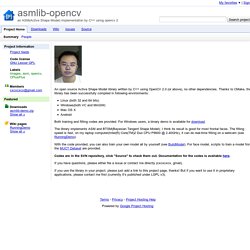
Thanks to CMake, the library has been successfully compiled in following environments: Linux (both 32 and 64 bits) Windows(both VC and MinGW) Mac OS X Android Both training and fitting codes are provided. For Windows users, a binary demo is available for download. The library implements ASM and BTSM(Bayesian Tangent Shape Model). I think its result is good for most frontal faces. With the code provided, you can also train your own model all by yourself (see BuildModel).
Cascade Classifier. Goal In this tutorial you will learn how to: Use the CascadeClassifier class to detect objects in a video stream.
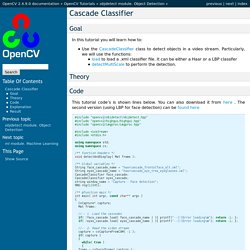
Particularly, we will use the functions:load to load a .xml classifier file. It can be either a Haar or a LBP classiferdetectMultiScale to perform the detection. Code. Facial feature detection. Answered Oct 3 '12 lightalchemist131 ● 2 ● 4 The Flandmark Facial point detector (with code) can be found here: It will return you the four corner points of the eyes, corner of mouth, center of nose, and center of face.
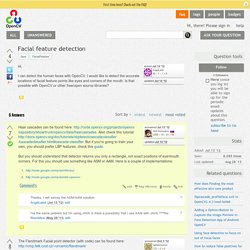
It does however require you to give it a bounding box of the face so you will probably have to use the Viola Jones face detector in OpenCV (or any other method) to locate the face first, which you are already doing. I've compiled the code on Ubuntu and it works very well, provided the bounding box you give it is "just right". I·bug - resources - Facial point detector (2010/2013) LEAR: Local Evidence Aggregation for Regression Based Facial Point Detection The LEAR programme detects 20 fiducial facial points.

Instead of scanning an image or image region for the location of a facial point, it can use every location in a point's neighbourhood to predict where the target point is relative to that location. A comparative study on illumination preprocessing in face recognition. A Key Lab of Intelligent Information Processing of Chinese Academy of Sciences (CAS), Institute of Computing Technology, CAS, Beijing 100190, Chinab Department of Computer Science and Engineering, Michigan State University, East Lansing, MI 48824, USAc School of Electrical Engineering and Computer Science, Peking University, Beijing 100871, China Received 22 February 2012, Revised 6 November 2012, Accepted 21 November 2012, Available online 1 December 2012 Choose an option to locate/access this article: Check if you have access through your login credentials or your institution Check access.
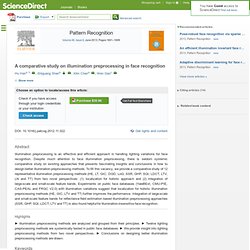
Welcome — Pylearn2 dev documentation. Pylearn2 is still undergoing rapid development.
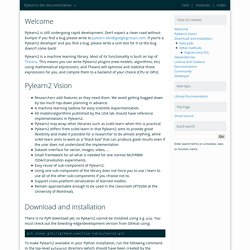
Don’t expect a clean road without bumps! If you find a bug please write to pylearn-dev@googlegroups.com. If you’re a Pylearn2 developer and you find a bug, please write a unit test for it so the bug doesn’t come back! (29) What is the difference between L1 and L2 regularization? Datasets — Pylearn2 dev documentation. Eric Yuan's Blog. Active Shape Model (ASM) Videofacerec.py example help. Asked Jul 12 '12 coredumped3 ● 1 ● 2 Hello, I'm currently doing some work in face recognition with small training data samples (typically only one per person).
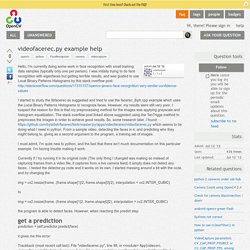
I was initially trying to do face recognition with eigenfaces but getting terrible results, and was guided to use Local Binary Patterns Histograms by this stack overflow post: I started to study the libfacerec as suggested and tried to use the facerec_lbph.cpp example which uses the Local Binary Patterns Histograms to recognize faces. However, my results were still very poor. I must admit, I'm quite new to python, and the fact that there isn't much documentation on this particular example, I'm having trouble making it work.
Whitening - Ufldl. From Ufldl Introduction We have used PCA to reduce the dimension of the data.
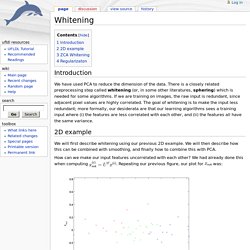
There is a closely related preprocessing step called whitening (or, in some other literatures, sphering) which is needed for some algorithms. If we are training on images, the raw input is redundant, since adjacent pixel values are highly correlated. The goal of whitening is to make the input less redundant; more formally, our desiderata are that our learning algorithms sees a training input where (i) the features are less correlated with each other, and (ii) the features all have the same variance. C++ - Facial Feature Points Detection using OpenCV. Visual Information Processing and Learning. Research topic #5: Lighting Preprocessing. UFLDL Tutorial - Ufldl. Matlab codes for dimensionality reduction. Color constancy in different illumination condition. William_ECCV_FaceRecognition.pdf. The INFace Toolbox. The INFace toolbox v2.1 includes (among others) implementations of the following photometric normalization techniques*:
Installation Instructions — The Face Recognition Library (FaceRecLib) 2.0.0b1 documentation. Download FaceRecLib To have a stable version of the FaceRecLib, the safest option is to go to the FaceRecLibs web page on PyPI and download the latest version. Nevertheless, the library is also available as a project of Idiap at GitHub. To check out the current version of the FaceRecLib, go to the console, move to any place you like and call: Tan-amfg07a.pdf. Illumination issue of face detection in OpenCV 2.x (or above)
Facerec/py/facerec at master · bytefish/facerec. Facereclib.preprocessing.TanTriggs. Is not available. ECCV 2012 Short Course Sparse Representation and Low-Rank Representation in Computer Vision -- Theory, Algorithms, and Applications Speakers: Yi Ma – Microsoft Research Asia John Wright – Columbia University, New York. Is not available. Google's Secretive DeepMind Start-up Unveils A "Neural Turing Machine" One of the great challenges of neuroscience is to understand the short-term working memory in the human brain. At the same time, computer scientists would dearly love to reproduce the same kind of memory in silico. Today, Google’s secretive DeepMind startup, which it bought for $400 million earlier this year, unveils a prototype computer that attempts to mimic some of the properties of the human brain’s short-term working memory.
The new computer is a type of neural network that has been adapted to work with an external memory. The result is a computer that learns as it stores memories and can later retrieve them to perform logical tasks beyond those it has been trained to do. DeepMind’s breakthrough follows a long history of work on short-term memory. Miller’s striking conclusion was that the capacity of short-term memory cannot be defined by the amount of information it contains.
Deep Learning, NLP, and Representations - colah's blog. LUO, Ping (羅平) Cvpr12_facealignment.pdf. Aligning face images. Some people have asked me how I've aligned the face images in my articles. Giving people my ImageMagick hack is embarrassing for me, so I've decided to rewrite it into a Python script. You don't need to copy and paste it, as the script comes with the source folder of my Guide on Face Recognition: crop_face.py. The code is really easy to use. To scale, rotate and crop the face image you just need to call CropFace(image, eye_left, eye_right, offset_pct, dest_sz), where: eye_left is the position of the left eyeeye_right is the position of the right eyeoffset_pct is the percent of the image you want to keep next to the eyes (horizontal, vertical direction)dest_sz is the size of the output image If you are using the same offset_pct and dest_sz for your images, they are all aligned at the eyes.
C++ Library: Real-Time Face Pose Estimation. Iccv07alignment.pdf. Visual Information Processing and Learning. The source codes and processed data can only be used for non-commercial purpose. Please make appropriate reference to our work if you are using the codes for your research. Thank you. Face Alignment. RGB Normalization - I'maKash. Segmentation is always a very important and basic task while detecting a particular object. Histograms - 2: Histogram Equalization. Goal In this section, We will learn the concepts of histogram equalization and use it to improve the contrast of our images.
Simple illumination correction in images openCV c++ A comparative study on illumination preprocessing in face recognition. Yi_Towards_Pose_Robust_2013_CVPR_paper.pdf. Cvpr12.pdf. CLM-WILD Code - Akshay Asthana. Facial Feature Detection. Flandmark - open-source implementation of facial landmark detector. / - asmlib-opencv - an ASM(Active Shape Model) implementation by C++ using opencv 2. I·bug - resources - Facial point detector (2010/2013) ValstarMartinezPantic_final.pdf. Convolutional Neural Networks - Andrew Gibiansky. Next, let's derive the backward propagation algorithms for these two layer types.
Convolutional Layers Let's assume that we have some error function, E, and we know the error values at our convolutional layer. What, then, are the error values at the layer before it, and what is the gradient for each weight in the convolutional layer? Note that the error we know and that we need to compute for the previous layer is the partial of E with respect to each neuron output (∂E∂yℓij). Let's first figure out what the gradient component is for each weight by applying the chain rule. Neural networks [9.3] : Computer vision - parameter sharing. [1409.6448] HSR: L1/2 Regularized Sparse Representation for Fast Face Recognition using Hierarchical Feature Selection. DeepLearning.University – An Annotated Deep Learning Bibliography.
SunWTcvpr13.pdf. Deep-learning-faces - C++, CUDA, and Matlab implementation of convolutional and fully connected neural nets. Research Detailed References. If you know where a researcher is from you can usually find more information on their work. Research group web sites (especially university sites) usually provide links to individuals in the group, descriptions of recent (and often past) work, and papers by members of that group (both past and present).
The group sites are the best source for finding specific information and for making contact with the individual researchers. This page lists research groups by country (alphabetical by the common (American) English name of the country). Each entry also includes a link to the people, known to the bibliography, that are in that group (based on the email or web address). Groups listed here are probably larger than a single research group. Computer Vision resources include: For more information on the topics, contact information, etc. see the annotated Computer Vision Bibliography or the Complete Conference Listing for Computer Vision and Image Analysis. Untitled - HuangCVPR12.pdf. Conferences : 2014 : Program : Deep Learning Multi-View Representation for Face Recognition. Xplore Full-Text PDF: Deepface.pdf. Deep Learning in Object Detection and Recognition - overview.pdf. Facebook shows off its deep learning skills with DeepFace.
1404.3606v2.pdf. Deep learning at the University of Chicago. Data transformation - Is whitening always good? Home Page of Geoffrey Hinton. Multimedia Laboratory. How Facebook's Machines Got So Good At Recognizing Your Face. Face Recognition with OpenCV. FaceRecognizer. Facerec_python.pdf. FisherFaceRecognizer in Python, segment fault. Fisherfaces. Bytefish/facerec. Facial Recognition in Python. Fisherfaces. Challenges in Representation Learning: Facial Expression Recognition Challenge. Face++: Leading Face Recognition on Cloud. Deep-learning-faces - C++, CUDA, and Matlab implementation of convolutional and fully connected neural nets.
Learning-Deep-Face-Representation.pdf. Features for face recognition. Face_rec12.pdf. Dlibrary/JIPS_v05_no2_paper1.pdf. Research.microsoft.com/pubs/132810/PAMI-Face.pdf. List of computer vision topics. Facial recognition system. Feature Selection in Face Recognition: A Sparse Representation Perspective. Cacm2011-researchHighlights-convDBN.pdf. Block-based Deep Belief Networks for face recognition. Face Detection Matlab Code. Www.ics.uci.edu/~xzhu/paper/face-cvpr12.pdf. Du_diss.pdf. Xplore Full-Text PDF: IEEE.TNN.face.recognition.hybrid.nn.pdf. Icml09-ConvolutionalDeepBeliefNetworks.pdf. Deep Learning Bibliography. Deep neural network face recognition.